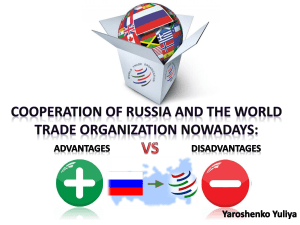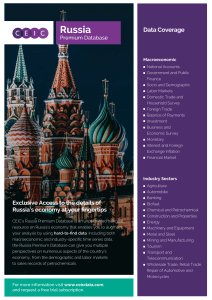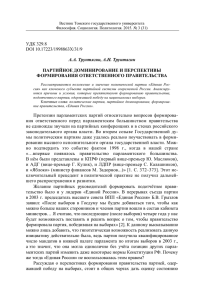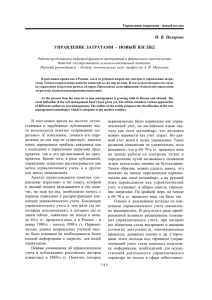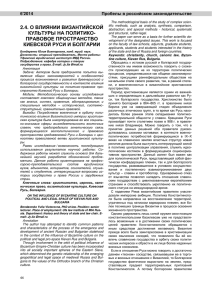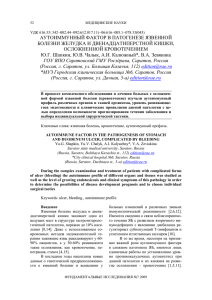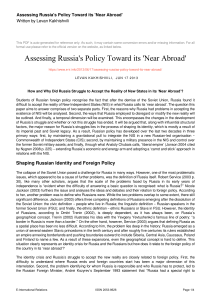A practical approach for Russia
реклама
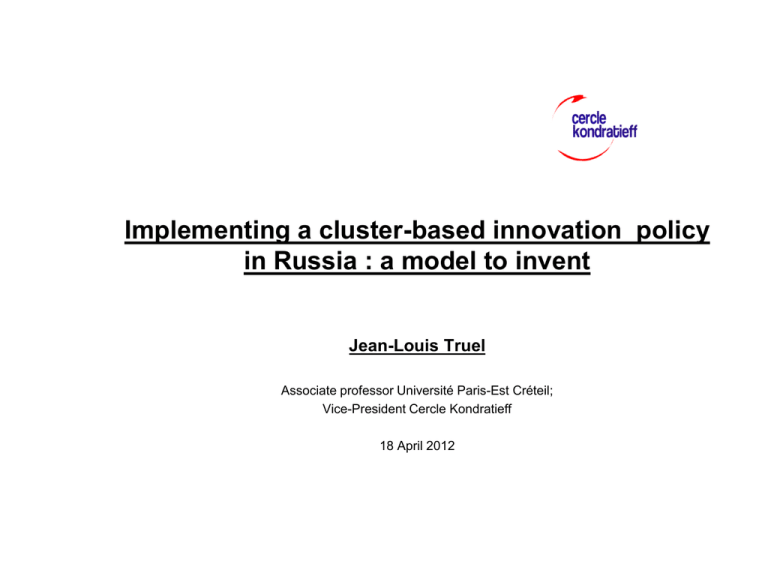
Implementing a cluster-based innovation policy in Russia : a model to invent Jean-Louis Truel Associate professor Université Paris-Est Créteil; Vice-President Cercle Kondratieff 18 April 2012 Разные Кластеры Современная концепция “кластеров” былa популяризована в 80-е. В течение последних 10 лет эта концепция возродилась в качестве инструмента индустриальной политики во многих европейских и азиатских странах. В Европе существует около 2000 различно организованных кластеров Кластеры «ориентированные на бизнес» В Северной Европе, в Италии, в некоторых регионах Германии, кластеры, в основном, «ориентированы на бизнес», т.е. ориентированы на межфирменную кооперацию. Они обычно существуют в форме организаций, зарабатывающих прибыль. Про-активный подход Во Франции, как и в некоторых других странах (Южной Корее, Южно-Африканской Рсеспублике), применяют более «проактивный» подход. . Стратегия определяется на государственном уровне. . Государственное финансирование. . Внутренняя организация: кластером совместно управляют предприятия, региональные и государственные власти. . Начилие постоянных структур поддержки предприятиям. Сочетание двух подходов Регионы все больше принимают участие в организации кластеров и в определении их общих направлений. . в Германии. . в Испании. . в Южной Америке: Аргентине, Чили, Бразилии. . в Индии: политика развития кластеров определяется на государственном уровне и осуществляется на региональном уровне. Более 6500 кластеров. В управлении кластерами плодотворно сотрудничают предприятия и государство. Justification for cluster-based innovation policies in Russia An economy still in transition . The 2008 crisis highlighted the weaknesses of the Russian economy . Absolute need for “modernisation”. . Issue at a national level – technological capability - as well as at a regional level – diversification. . Lack of entrepreneurial culture. . Strong state influence. Need to invent new tools for development Justification for cluster-based innovation policies in Russia Russia at crossroads : how to to it . New concept = mix between clusters, technoparks, special economic zones, Skolkovo… . Contradictory influences . Strong focus on fiscal policies . No clear-cut central policy . Many initiatives in the regions . Problem of financing Justification for cluster-based innovation policies in Russia The current status : many initiatives . SEZ . Clusters . Technoparks . Skolkovo A practical approach for Russian clusters Some clusters have a bottom-up approach (on the model of Northern Europe) . Limited State involvement . Focused on intercompany-cooperation . Run as profit-making organisations. Example : Saint-Petersburg A practical approach for Russian clusters Strong interest in the French experience . Top down impulse with significant State or regional government involvement . Technology focus. Major R and D projects at the initial stage . Public and private participants . Strong organisational support. Permanent support staff A practical approach for Russia : case study Context . Industrial region . Good educational system . Several successful companies . Need to develop the regional environment . Common will of regional government and of some companies to develop clusters A practical approach for Russia : case study Determination of the objectives of a cluster Why a cluster? . Providing a framework for public policy in terms of economic development, but also of education and research policy. . Giving a favourable environment for developing technological capabilities: organising cooperation between public research centres, local authorities, larges corporations and SMEs . Providing services to participating companies, especially start-ups and SMEs. . Strengthening existing companies. . Giving national and international visibility. A practical approach for Russia : case study Determination of the priorities in the course of implementation . Creation of a complete ecosystem, integrating the whole value chain from education and research to market access. . Choice of a top down approach (limited number of existing companies). . Special attention paid to organisational support and development of market opportunities. Already existing programme for SMEs. A practical approach for Russia : case study Involvement of all stakeholders Key factors: involve all types of organisations and strongly push synergies between them. R and D synergies. Not obvious in this specific case. Worked with other Russian clusters. Market synergies. . intra cluster synergies. May work if large companies push them. . inter-cluster synergies. The overall dynamics is not strong enough. . public purchasing policies. Ex : geographical information. Training/ relations with universities Cluster can be a strong incentive for the best students to go to these Universities. This implies more resources for the universities. Possibility : cluster sponsored programmes (already exists at the level of individual firms) A practical approach for Russia : case study Specific actions towards SMEs . Support for business creation. Entrepreneurs must have support in developing their innovation into a business. Already started. . Support for search of financing: training on “how to present an attractive business plan”, meetings with investors... Since participation in clusters is linked to a committee approval, this gives a first level of legitimacy. . Dissemination of information. Having a well-documented website which provides information on IT industry, technology, business regulations.... . Networking. . Support in the development of relations with larger cluster members. A practical approach for Russia : case study Financing . Clearly a weak point. . Small participation from the region. . Not much money from private investors. A practical approach of clusters : a few guidelines . Clusters are definitely relevant for regional policies. . Knowledge of cluster policy tools is not widespread in Russia. . Need for strong political commitment from regional authorities. . Companies have to be motivated need for success stories . The importance of immaterial factors should be put forward. . Financing solutions must be worked out. Спасибо за внимание
